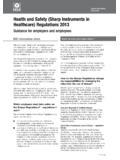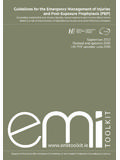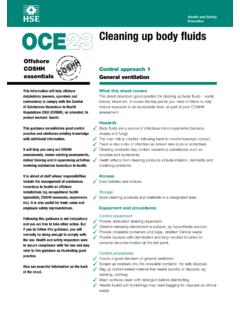Transcription of Needlestick Safety and Prevention - WHO
1 1 American Nurses Association Independent Study Module Needlestick Safety and Prevention ABSTRACT Every day, health care workers are exposed to dangerous and deadly bloodborne pathogens through contaminated needlesticks, sharps, or splash exposures. It is one of the greatest risks faced by the frontline health care worker. Yet, these exposures have often been considered part of the job. The Needlestick Safety and Prevention Act was signed into law in November 2000 and became effective in April 2001. The passage of this federal Needlestick legislation was part of a plan by the American Nurses Association (ANA) and other health care worker advocates to achieve an amendment to the federal Occupational Health and Safety Administration (OSHA) Bloodborne Pathogens Standard.
2 The purpose of this Indedpendent Study Module is to inform nurses about the law, the additional protections it provides, and present other strategies the nurse can use to reduce occupational exposure to bloodborne pathogens. OBJECTIVES 1. Identify five key components of the Needlestick Safety and Prevention Act of 2000. 2. Discuss the impact of safe practice/safe needle devices on nurses health and well being. 3. Explain the key elements of the OSHA Compliance Directive for the Bloodborne Pathogens Standard and strategies for identifying and reporting non-compliance. 4. Explore proactive strategies for promoting a culture of Safety in the workplace.
3 5. Describe ANA activities to promote health and Safety in the workplace for nurses. AUTHORS Mary Foley, MS, RN Mary Foley is the Immediate Past-President of the American Nurses Association. She received a Master's degree in nursing administration and occupational health and is currently in a PhD program in nursing policy. She has worked at the hospital, state, and national level to address healthcare worker Safety , particularly in the area of Needlestick injury Prevention . Annemarie T. Leyden, EdD, RN Dr. Annemarie T. Leyden is Chief, Learning Resources (Director of Education) at the VA New York Harbor Healthcare System in New York City. She is a Clinical Specialist in Medical/Surgical Nursing and serves on the VA NY Harbor Safety Committee.
4 She was appointed as an Expert Advisor to the ANA Safe Needles Save Lives project in 2002-2003 funded by an OSHA Susan Harwood Training Grant. Dr. Leyden recently 2 completed a doctorate in Leadership and Organizational studies with a focus on Adult Learning at Columbia University in New York City. INTRODUCTION Work-Related Bloodborne Pathogen Exposure: The Risks for Health Care Workers Every percutaneous Needlestick and sharps injury carries a risk of infection from bloodborne pathogens. Yet, these exposures often have been considered part of the job. Health care workers primarily are exposed to these pathogens via contaminated Needlestick and sharps injuries.
5 You probably know at least one colleague who has sustained an injury, or perhaps you have been stuck yourself. It is important that you and your colleagues fully understand these risks. The Facts About Occupational Infection: Every year, health care workers experience between 600,000 and 800,000 exposures to blood (United States Department of Labor-Occupational Safety and Health Administration [USDOL-OSHA], 2001). Registered nurses working at the bedside sustain an overwhelming majority of these injuries (Perry, Parker, & Jagger, 2003). These exposures carry the risk of infection with Hepatitis B (HBV), Hepatitis C (HCV), and Human Immunodeficiency Virus (HIV), the virus that causes AIDS.
6 Each of these viruses poses a different risk if a health care worker is exposed. More than 20 other infections can be transmitted through needlesticks, including syphilis, malaria, and herpes (Centers for Disease Control and Prevention [CDC], 1998a). At least 1,000 health care workers are estimated to contract serious infections annually from Needlestick and sharps injuries (International Health Care Worker Safety Center, 1999). According to the National Institute of Occupational Safety and Health (NIOSH), the design of the device can increase the risk of injury. Specific features make certain devices more dangerous. These include: (National Institute for Occupational Safety and Health [NIOSH], 1999).
7 Devices with hollow-bore needles. Needle devices that need to be taken apart or manipulated by the health care worker-like blood-drawing devices that need to be detached after use. Syringes that retain an exposed needle after use. Needles that are attached to tubing-like butterflies that can be difficult to place in sharps disposal containers. The highest risk of injury is from blood-filled hollow-bore needles. They accounted for 63% of the Needlestick injuries from June 1995-July 1999 (NIOSH, 1999). Ninety 3 percent of the Centers for Disease Control and Prevention (CDC) documented cases of health care workers who contracted HIV from Needlestick injuries involved injuries with hollow-bore, blood-filled needles (CDC, 1998a).
8 This data may appear to be old , dating back five or six years. It continues to have relevance when discussing the 2000 Needlestick Safety and Prevention Act since it was the science available at the time the law was debated, and ultimately, passed. This data proved to be very persuasive, and helped make the case for the law. Current data suggest that improvements in the design and distribution of equipment are making a positive impact on the incidence of needlesticks. Many references are provided that will direct the reader to data that is continuously updated and reflects current science. Some of the websites cited are continuously monitoring the epidemiology of these injuries and should be used in current discussions of the subject.
9 4 Figure 1. Hollow-bore needles and other devices associated with percutaneous injuries in CDC surveillance hospitals, by % total percutaneous injuries (n=4,951), June 1995-July 1999. Figure 2. Causes of percutaneous injuries with hollow-bore needles in CDC surveillance hospitals, by % total percutaneous injuries (n=3,057), June 1995-July 1999 9(NIOSH, 1999). Manipulating Needle in Patient 27% Disposal-Related Causes 12% Handling /Passing 11% Cleanup 11% Improper Disposal 10% IV Line-Related Causes 8% Collision with HCW or Sharp 8% Recapping 5% Handling/Transferring Specimens 5% Other 4% (NIOSH, 1999) Winged-Steel Needle 13% Hypodermic Needle 29% IV Stylet 6% Glass 17% Suture Needle 15% Other Hollow-Bore Needle 10% Phlebotomy Needle 4% Other Sharp 6% (NIOSH, 1999) 5 HIV/AIDS HIV Transmission From Infected Patients to Health Care Workers.
10 While the transmission rate of occupationally acquired HIV remains very low, AIDS is a debilitating and ultimately fatal disease, making each potential exposure a frightening experience. Many nurses throughout the world are living with occupationally acquired AIDS, and many have died from it. Concerns about HIV contaminated blood led to the 1991 OSHA Bloodborne Pathogens Standard and CDC s Universal Precautions. The transmission rate of occupationally acquired HIV after an exposure is (1 in 300). In other words, if a health care worker is stuck by a needle or cut by a sharp that is contaminated with the blood of an HIV patient, there is a 1 in 300 chance that she or he will be infected with HIV.

















